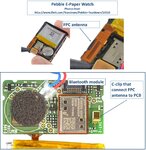chris_la
Newbie level 2

Hi!
I am new here and this is my first post! I have looked around on the forum for info on FPC antennas, but have not found the info I need. I am thankful for guidance on the subject!
I am from time to time designing devices with Bluetooth functionality. I have always used printed circuit antennas (in rigid PCB) or chip antennas in these designs without really taken the time to look into whether an FPC (flexible printed circuit) antenna could be a better option.
I have seen 2 types of FPC antennas:
1) antenna assembly including coaxial cable and connector. There are many off-the-shelf antennas of this type available. Quite expensive compared to most chip antennas. Examples:
**broken link removed**
2) antenna that is just a piece of FPC without cable or connector, and that is connected to PCB via c-clips. Example in attached figure. I have not found any off-the-shelf antennas of this type. Looks like it should be inexpensive. As price is always a heavy factor in the products I am working with this is the type I am most interested in.
Is there anyone here having experience in type 2 above? I would like to get an understanding of when it is advantageous to use the type 2 FPC antenna instead of a chip antenna. A clear advantage is the smaller space required. Are there any more advantages? What are the disadvantages?
How do the type 2 FPC antenna compares to a chip antenna in terms of price and performance? Are there type 2 FPC off-the-shelf antennas available (have not found any) or do they have to be custom designed in order to take into account the surrounding structures?
Thanks,
Chris

I am new here and this is my first post! I have looked around on the forum for info on FPC antennas, but have not found the info I need. I am thankful for guidance on the subject!
I am from time to time designing devices with Bluetooth functionality. I have always used printed circuit antennas (in rigid PCB) or chip antennas in these designs without really taken the time to look into whether an FPC (flexible printed circuit) antenna could be a better option.
I have seen 2 types of FPC antennas:
1) antenna assembly including coaxial cable and connector. There are many off-the-shelf antennas of this type available. Quite expensive compared to most chip antennas. Examples:
**broken link removed**
2) antenna that is just a piece of FPC without cable or connector, and that is connected to PCB via c-clips. Example in attached figure. I have not found any off-the-shelf antennas of this type. Looks like it should be inexpensive. As price is always a heavy factor in the products I am working with this is the type I am most interested in.
Is there anyone here having experience in type 2 above? I would like to get an understanding of when it is advantageous to use the type 2 FPC antenna instead of a chip antenna. A clear advantage is the smaller space required. Are there any more advantages? What are the disadvantages?
How do the type 2 FPC antenna compares to a chip antenna in terms of price and performance? Are there type 2 FPC off-the-shelf antennas available (have not found any) or do they have to be custom designed in order to take into account the surrounding structures?
Thanks,
Chris




